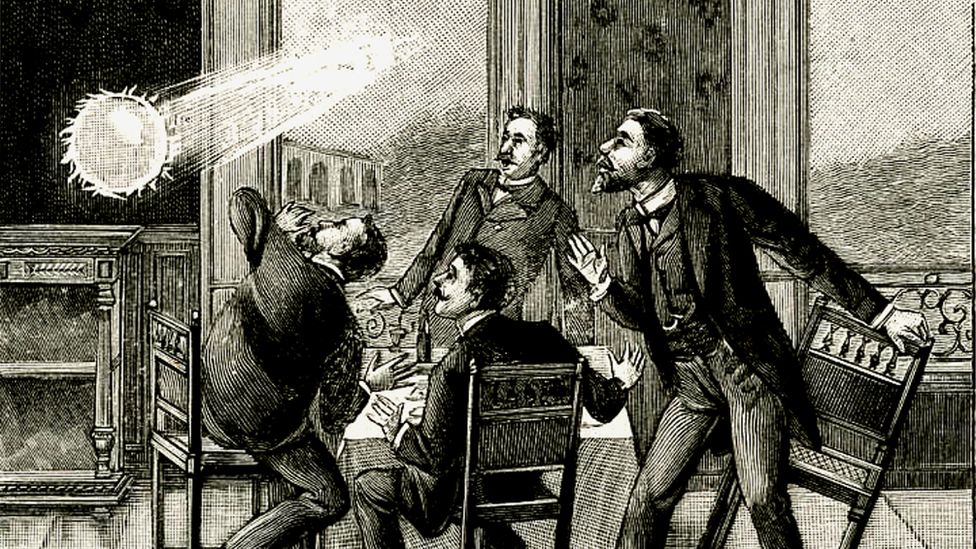Is this England's earliest report of ball lightning?
- Published

1901 engraving depicting ball lightning.
Researchers at Durham University have discovered what appears to be the earliest known account of ball lightning in England.
The research has found what seems to be the first reference to it in a text written 750 years ago.
Ball lightning is usually associated with thunderstorms, is unexplained and has been described as a bright spherical object on average 9in/25cm, but sometimes up to several metres, in diameter.
The rare weather phenomenon now appears to have been documented by a monk in a medieval text.
This extract from the Chronicle of Gervase of Canterbury, where the medieval monk describes the ball lightning phenomenon, is the earliest known description of ball lightning in England to have been found
"A marvellous sign descended near London"
The account by the 12th century Benedictine monk Gervase of Christ Church Cathedral Priory, Canterbury, Kent states: "A marvellous sign descended near London" on 7 June 1195.
He went on to describe a dense and dark cloud, emitting a white substance which grew into a spherical shape under the cloud, from which a fiery globe fell towards the river.
Physicist Emeritus Professor Brian Tanner and historian Professor Giles Gasper of Durham University made the connection to a ball lightning event after comparing the text in Gervase's medieval Chronicle with historical and modern reports of ball lightning.
Cumulonimbus clouds over Chandler, Arizona, USA, in 2018, showing the inverted pyramid with the dark cloud beneath.
Professor Tanner said: "Ball lightning is a rare weather event that is still not understood today.
"Gervase's description of a white substance coming out of the dark cloud, falling as a spinning fiery sphere and then having some horizontal motion is very similar to historic and contemporary descriptions of ball lightning."
Medieval writings rarely survive in the author's original version and Gervase's Chronicle and other works now only exist in three manuscripts. One is in the British Library, and two are at the University of Cambridge.
A spectacular event
"It is fascinating to see how closely Gervase's 12th century description matches modern reports of ball lightning," added Professor Tanner. "There are even videos on the internet that show some of the effects he was describing.
"We should not dismiss medieval descriptions of the natural world as being mired in superstition and therefore of no value. This event was evidently sufficiently spectacular for it to merit special mention in the chronicle. Ball lightning was not understood then and it is still not understood now."
Path of ball lightning observed at the Hotel Georges du Loup. near Nice in France.
A convincing account
The main focus of Gervase's writings was Christ Church Cathedral Priory in Canterbury, its disputes - with neighbouring houses and an Archbishop of Canterbury, as well as chronicling the actions of the king and his nobles, explained Professor Giles Gasper.".But he [Gervase] was also interested in natural phenomena, from celestial events and signs in the sky to floods, famine, and earthquakes."
The researchers looked at Gervase's credibility as a writer and a witness, having previously examined his records of eclipses and a description of the splitting of the image of the crescent moon.
Professor Gasper added: "Given that Gervase appears to be a reliable reporter, we believe that his description of the fiery globe on the Thames on 7 June 1195 was the first fully convincing account of ball lightning anywhere."
The mystery of ball lightning
You've probably never seen ball lightning because it is so rare.
BBC Weather's Susan Powell said: "Modern technology allows us to observe our weather in more detail than ever before and understand with greater depth.
"Ball lightning however remains elusive and it's the subject of many theories. It's interesting to think that in this respect, despite our advances, we stand as mystified as observers in the 12th century."